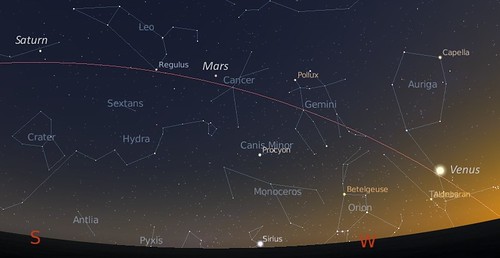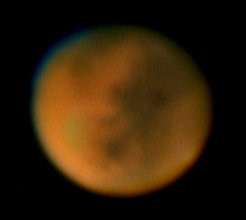Summer begins this month, and because the Sun is not setting until after 9pm, darkness does not begin until 10pm. But there is plenty to see this month if you are willing to stay up a bit later.
As soon as it begins to get a bit dark, look towards the sunset, and by 10pm you will be able to see the planet Venus, very low in the sky. It looks a bit like an aircraft coming in to land… but if it is still there 10 minutes later, and hasn’t landed, then you have found Venus!
Look to the left of Venus, and slightly above it, and you will notice a red object – the planet Mars. During the month, Mars is close to the star Regulus, at equal brightness but not as red. On the 6th of June, Mars passes only 1 degree away from Regulus as it moves around the Sun and so moves around the sky.
Then look to the top left of Mars, and you have Saturn, which appears to be quite bright and slightly yellow in colour.
Venus is setting at about 11.30pm, with Mars following it an hour later, and then Saturn is setting an hour after that.
The positions of the planets can be seen in this movie below.
If you now look in the other direction towards the stars rising in the South-East (see graphic below, set at 22:30BST), you will see three bright stars – Deneb, Vega and Altair. Those three stars are known as the summer triangle of stars, and are fascinating in their own right. Vega has a dusty disk around it and maybe a planet; Altair rotates in just 7 hours, making it bulge around its equator; and Deneb is one of the brightest stars we know of. Deneb is over a 100 times further away than both Vega and Altair, but it looks equally bright because it is so big – at least 200 times the diameter of the Sun! If Deneb was as close as Altair, it would be almost as bright as the full Moon!
I will be writing more about what can be seen in this patch of sky over the coming months, as the Earth moves around the Sun to get a better look at this patch of the night sky.




